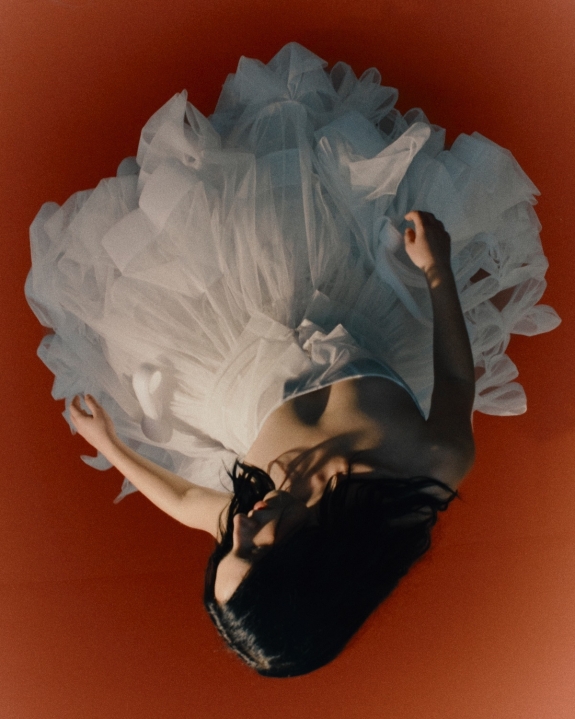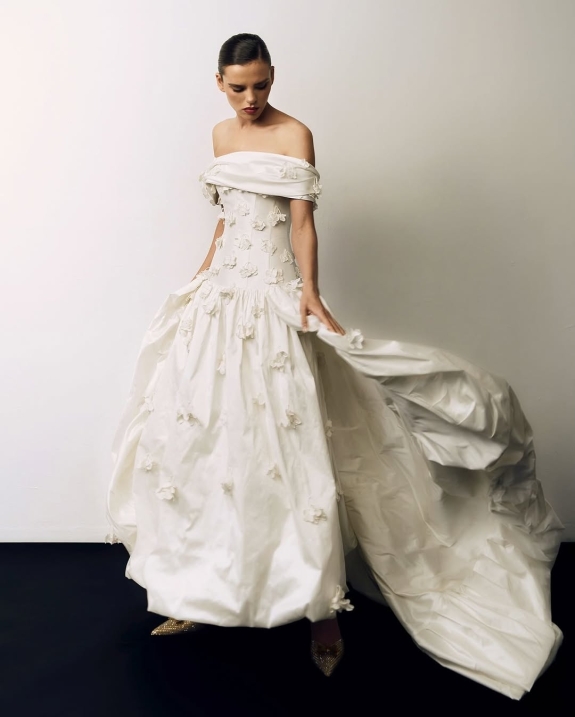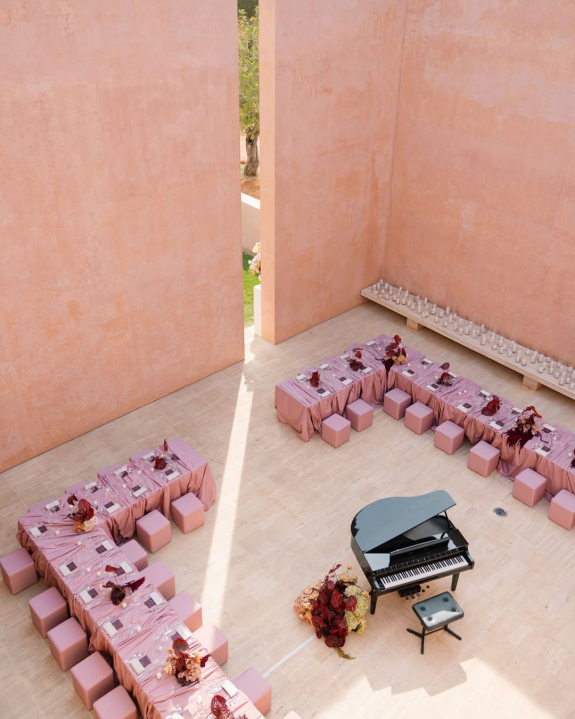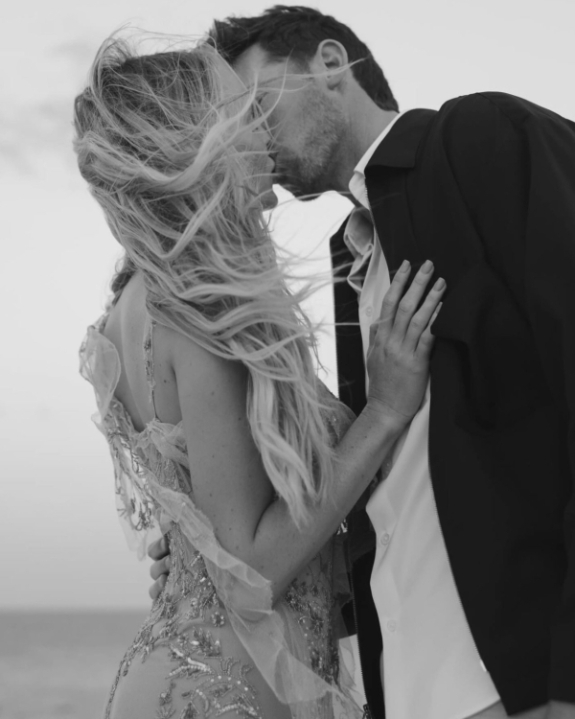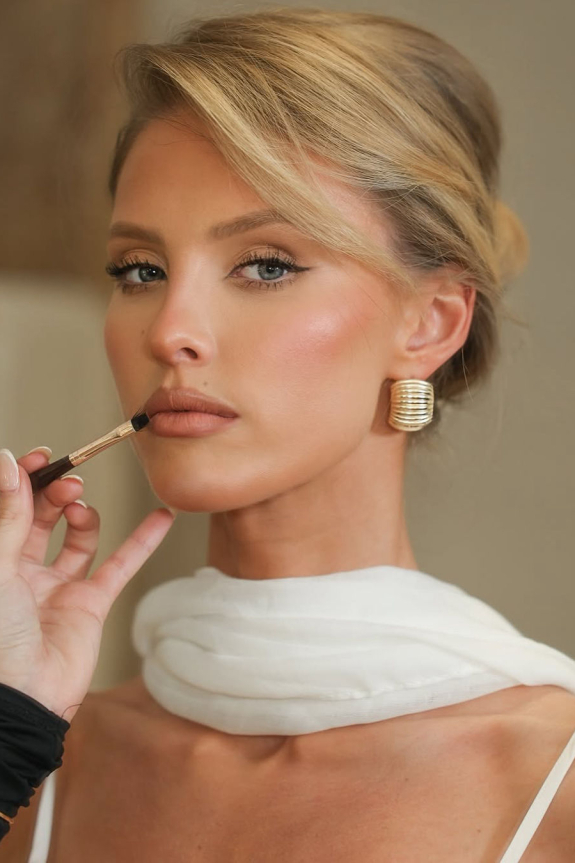Few designers have captured the mood of a generation the way Marcelo Gaia has. His brand, Mirror Palais, exists at the intersection of memory and modernity, where bias-cut silk feels cinematic, off-white is the new ivory, and the bridal gown has quietly become a cultural object of desire. The women who wear his dresses might have first discovered them in a Pinterest save folder long before a proposal, but that’s part of the brand’s quiet magic: Mirror Palais makes you dream before you even know what you’re dreaming of.
In the space between vintage glamour and contemporary edge, Gaia has built a world that feels personal, romantic, and unmistakably modern. His approach to bridal, and fashion at large, has helped redefine what femininity looks like today: less about perfection, more about presence; less about being adorned, more about feeling in the moment. Here, the designer pulls back the curtain on the origins of Mirror Palais, the iconic pieces that fueled its viral rise, and how bridal — now an integral part of the brand — found him along the way.
Designing Through
the Female Lens
For Gaia, the story of Mirror Palais begins with the women who inspired him. Raised by his mother and older sister, and surrounded by women throughout his life, his creative perspective was formed by observing and admiring them. “They really informed my sensibilities and shaped my sensitivity,” he says. “When I’m creating, I’m trying to honor women, from those who’ve been a part of my life, like my mom, to the icons of old Hollywood and pop culture."
That admiration soon merged with another love: fashion. “I grew up really loving fashion, particularly vintage. I did a lot of thrifting when I was young. I think Mirror Palais came from that mix — my appreciation of femininity, creativity and the nostalgia of vintage.” That reverence for femininity shows up in every detail of his work, from hand-finished seams to silhouettes that feel lifted from another era.
A Natural Instinct for Bridal
Ironically, Gaia didn’t initially set out to design wedding dresses. His now-signature use of butter and cream tones began as a personal preference, shades he found flattering, light-reflective, and quietly sensual. “I’ve always really liked cream and off-white tones. I wear shades of white and lots of butter colors in my day-to-day wardrobe, so early on I was just using those tones in my designs, without thinking directly about bridal. Then one of my dresses, The Plunging Back Cowl Dress, went viral.”
The bias-cut gown, with its low back and fluid silhouette, became a hit online. But Gaia soon realized the influx of orders flooding in weren’t for just any event, they were for weddings. “At first, I thought people just really liked it,” he laughs. “Then our customer-service team started telling me, ‘This dress really has to arrive in time, it’s for a bride.’ And then it kept happening. I’d design another white dress, and again I’d hear, ‘This one’s time sensitive, the bride needs it!’ That’s when it clicked — brides were coming to us before I even knew I was designing for them.”
That organic moment became a turning point. What began as a color story evolved into a full-fledged bridal collection, a natural extension of the brand’s romantic spirit. “When I design any collection, there’s always going to be that cream or off-white color integrated into the looks. I’ve always been drawn to it. But now I just know who it’s for. I tailor certain designs with that in mind — for example, making sure a bridal piece has full opacity over the bust versus something sheer that might not be right for the occasion.”
When Bridal Becomes a Feeling
While the Plunging Back Cowl Dress may have sparked Mirror Palais’s bridal chapter, the pathway towards bridal was always there. Signature designs were reimagined for the bride, such as the Cascading Ruffle Gown, originally created in deep red for his first runway show, it then took on a new life when Gaia later reimagined it in white, “it became very ethereal — a romantic piece born out of chaos." That longevity and evolution, he admits, is part of what makes each dress special. “I love that they have that staying power. When first starting out as a small business, when you find your niche — that sort of hero piece — it’s very gratifying.” Gaia’s designs carry a sense of ease, made to be worn, not just admired. Brides often tell him they’ve re-worn their dresses to dinners or vacations, something he quietly takes pride in. “Our dresses are wearable. They’re comfortable, soft. Brides put them on again because they want to — not because they feel they should.” And comfort, for him, isn’t the opposite of glamour. It’s what makes it last. “When brides try on our pieces, they start moving differently. It’s not just about how they look — it’s about how they feel in them. That’s what I want for them: joy, confidence, presence.”
The New Era of Bridal
Gaia’s designs have become synonymous with a new era of wedding fashion — expressive, slightly rebellious, and deeply personal. His approach to bridal goes far beyond the ceremony gown, reimagining the wedding wardrobe as a series of moments that reflect a bride’s individuality. “The bridal wardrobe has become bigger than ever,” Gaia says. “It’s this carefully considered, multi-look element of modern weddings, and I designed my first collection with that in mind — from the brunch look to the short, fun-to-wear party dress to the ceremony gown. It gives people more room to play. Maybe she’s always envisioned a classic A-line gown for the ceremony, but now, with the shift toward individuality, she can experiment with something bolder for the other events." And for him, that’s what makes this new bridal era so exciting. “People want to feel really confident about themselves and how they’re expressing themselves. Being a bride is an opportunity to really shine — and I think they’re looking to stand out as well.”
Today’s weddings, Gaia notes, reflect a new level of creativity and storytelling. With tools like Pinterest and social media, brides are curating every detail with intention. “People are thinking more holistically now. If you’re getting married at city hall, that’s going to look and feel different than a villa in Italy. Because we all have more creative control, you’re able to really envision yourself and think, ‘How does this fit into the grand scheme of the day?’ The ceremony format might be traditional, but the expression is personal — it’s about how you make the performance your own.”
Designing for the Digital Age
Mirror Palais didn’t just find its audience online — it built one. Gaia’s understanding of social media feels instinctive, rooted in observation rather than strategy. “I’m listening to people. When something goes viral, it means it got someone to react. That’s emotion, and emotion drives everything. I pay attention to what resonates and give them more of that. He acknowledges the algorithm as a creative collaborator of sorts, shaping the rhythm of his releases and revealing what truly connects with his audience, while still staying true to his vision. But he also values the discourse that comes with visibility. “I think feedback is important. Not everyone’s perspective reflects a shared reality, but there’s often a general consensus worth noting. You have to listen — just maybe not to everyone.”
That awareness extends to how Gaia approaches content for Mirror Palais itself. “Everything you see on our Instagram and TikTok is either taken by me or directed by me,” he says. His videos often pull back the curtain on his design process, inspirations, and the quiet details behind each collection. Shot almost intentionally unvarnished, the clips carry a sincerity that feels rare in fashion — making the brand feel both aspirational and human, romantic yet real.
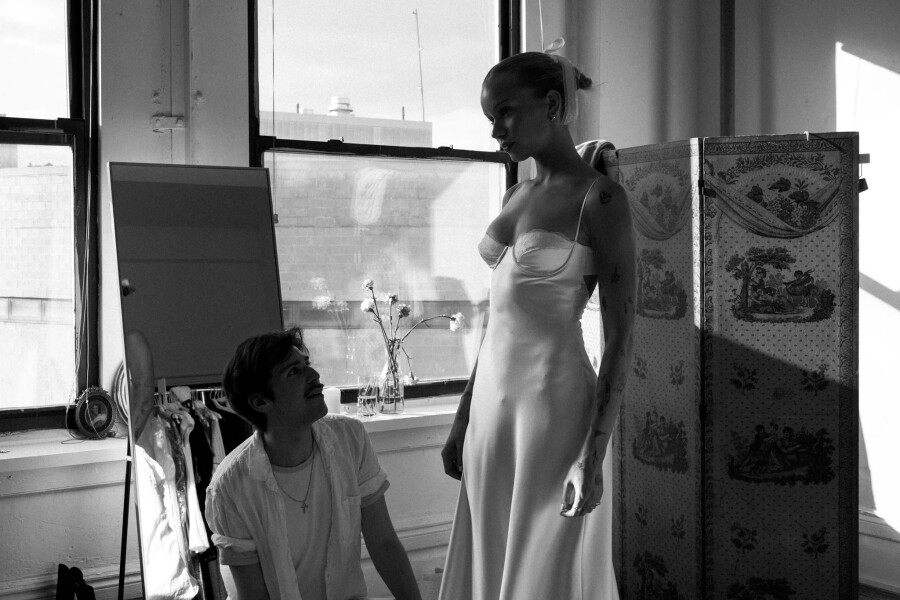
The Next Chapter
As Mirror Palais continues to expand, both in reach and physical space, Gaia’s vision remains rooted in intimacy. “We’re expanding into another space in our building so we can regularly host appointments. By 2026, we’re hoping to open a beautiful showroom with a section dedicated just to bridal.” It’s been a few years since Gaia’s last full bridal collection — but that’s about to change. A new one is planned for 2026, “more adventurous and more beautiful,” as he puts it. “Bridal makes up a big part of our business, and it’s growing. I want to keep making pieces that become part of people’s stories.”
In many ways, Mirror Palais has already done that, giving brides something few designers offer: romance with restraint, nostalgia without imitation, and gowns that feel as current as they do eternal. The women who wear Mirror Palais aren’t chasing tradition — they’re making it their own, one butter-yellow gown at a time.
















